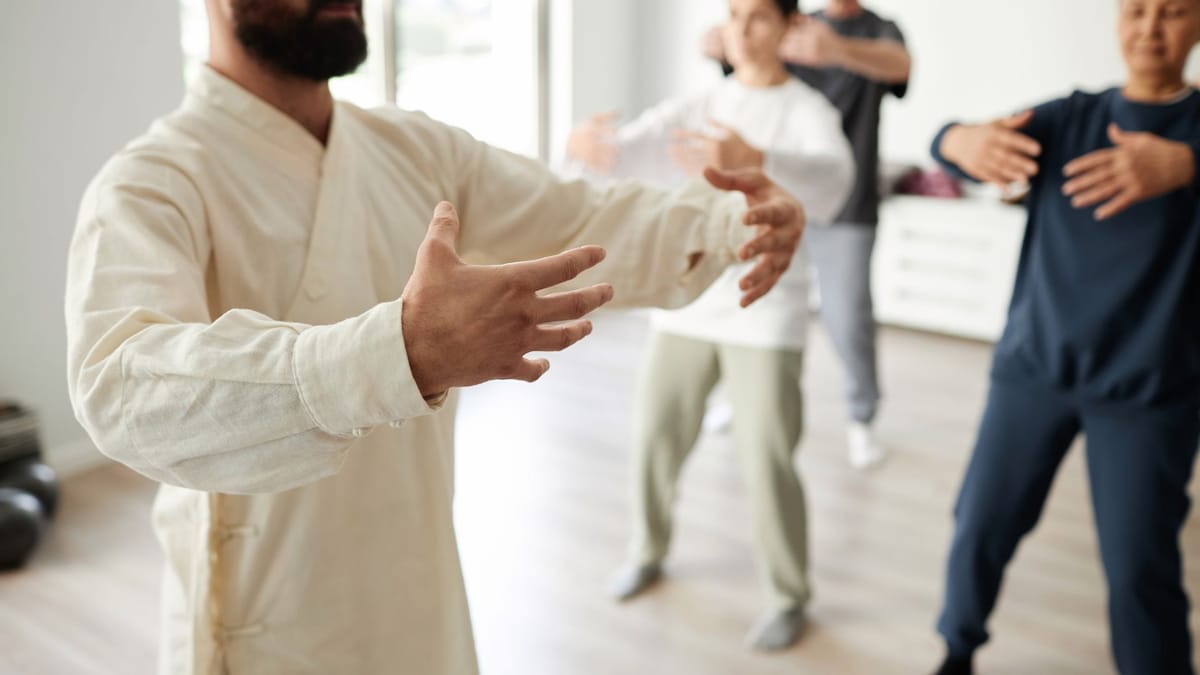Discover balance and vitality through timeless techniques for mind and body wellness
As the world increasingly emphasizes wellness and holistic health, ancient practices like Qi Gong are gaining popularity.
With origins dating back thousands of years, this practice isn't just a set of exercises. It's a powerful way to connect the body, mind, and spirit. For those captivated by ancient wisdom, Qi Gong provides a unique path that aligns with nature's rhythms and taps into a universal energy field known as "qi."
But what is Qi Gong? And why are so many people drawn to it?
In this article, we will trace the evolution of this timeless tradition, from its historical roots to its modern-day practice. So, whether you're just starting out or looking to deepen your understanding, read on to discover the transformative potential of Qi Gong.
What is Qi Gong in a nutshell?
Qi Gong is an ancient Chinese practice that combines physical postures, movement, breathing techniques, and meditation. Qi Gong translates to energy (qi 气) work (gong 功). And it reflects the fundamental goal of cultivating and balancing one's internal life energy or qi (which is, by the way, the same as "chi"). This practice is a big part of Chinese culture, shaping martial arts, medicine, and spiritual traditions.
Qi Gong covers a wide variety of techniques, all aimed at boosting the flow of qi through the body's meridian system. By balancing their qi, people aim for better health, sharper mental focus, and emotional balance. Unlike other forms of exercise, Qi Gong focuses on slow, deliberate movements (or no movements at all), making it easy for people of all ages and fitness levels to join in.
But this practice isn't just about physical health. It also supports spiritual growth and self-awareness. By blending breath control and focused intention, people develop a meditative state that boosts inner peace.
Qi Gong also often gets compared to Tai Chi. While both involve movement and energy flow, Tai Chi tends to focus more on martial arts applications.
Historical and cultural roots of Qi Gong
Qi Gong has a fascinating history that dates back to ancient China. While its beginnings are wrapped in myth and legend, most scholars agree it started developing around 5,000 years ago.
It originated from ancient shamanistic practices along with Daoist philosophy and Buddhist teachings. Its journey is closely linked with the growth of traditional Chinese medicine (TCM), philosophy, and martial arts. Over the centuries, Qi Gong has evolved into a wide-ranging practice with different schools and styles.
The practice first gained recognition during the Warring States Period (475-221 BCE) but grew in prominence during the Han Dynasty (206 BCE-220 CE). It was initially used for healing and maintaining health. Often incorporated into traditional Chinese medicine as a complementary therapy. Monks in Buddhist and Daoist temples practiced Qi Gong for spiritual cultivation and physical conditioning.
Historically, Qi Gong was closely guarded within families, temples, and martial arts schools. But in recent decades, it has become widely accessible, benefiting people worldwide seeking holistic health practices.
6 key principles of Qi Gong
At its core, Qi Gong revolves around six central principles:
- Qi: At its core, Qi Gong is all about cultivating and balancing one's internal life energy known as qi.
- Balance: The ancient Chinese believed that all things contain complementary energetic forces known as Yin and Yang. These opposites balance each other out to create harmony and achieve health. In Qi Gong practice, movements aim to balance the body's Yin and Yang energy while fostering balance between the physical, emotional, and spiritual realms.
- Intention: In Qi Gong, you cultivate focused awareness of the movement of qi within the body. You direct intention (yi 意) to guide the flow of qi. By directing your intention to specific parts of your body, you create a more profound connection with your inner energy. As you progress in your practice, your intention becomes more refined and subtle, helping you work with your qi on a deeper level.
- Mindfulness: Qi Gong is a deeply meditative practice that encourages mindful awareness of the present moment. By focusing on the movements, breath, and energy flow, you cultivate a state of inner stillness and peace.
- Breath control: Qi Gong uses intentional breathing techniques to connect mind and body. By concentrating on deep, slow breaths, you can calm your mind and enhance the flow of qi throughout your body.
- Movement (or stillness): Depending on the style, Qi Gong can involve gentle movements or standing meditations. Both aim to cultivate the flow of qi within the body.
The Qi in Qi Gong
At the core of Qi Gong is the idea of qi. It's a vital force central to traditional Chinese medicine and philosophy. You can think of qi as the essential life energy that fills every living thing. It's the unseen force that energizes the cosmos, moves through nature, and keeps the human body vibrant.
In Qi Gong practice, qi isn't just a theory—it's a real presence that practitioners learn to feel and use. Cultivating qi involves focusing on its flow through the body's meridian system, connecting your physical self with the universal energy stream. Balanced and harmonious Qi leads to optimal health, mental clarity, and emotional equilibrium, guiding practitioners toward a state of holistic well-being.
Philosophical foundations of Qi Gong
Daoist philosophy plays a crucial role in shaping Qi Gong, highlighting the importance of living in harmony with nature and the natural flow of qi.
Daoism teaches that everything in the universe is interconnected and should move in balance and harmony. This principle is central to Qi Gong practice, where aligning oneself with the rhythm of nature is key to harnessing Qi effectively. You learn to go with the flow, just like a river naturally follows its path, letting Qi move freely and unstifled within your body.
Qi Gong encourages you to achieve a state of balance where the mind, body, and spirit connect as one. This unity brings a deeper sense of peace, health, and vitality. This reflects the Daoist idea of effortless action and natural balance.
By practicing Qi Gong, you tap into an ancient wisdom that nurtures both inner strength and tranquility.
P.S. If you're curious about the philosophical roots of Qi Gong and Eastern traditions, check out our in-depth article on Eastern philosophy. It dives into Daoism, breaking down its concepts and teachings that shape practices like Qi Gong:

3 main types of Qi Gong
Qi Gong is a multifaceted practice with various styles, each tailored to specific needs and purposes. But broadly, Qi Gong can be categorized into three main types:
Medical Qi Gong
Medical Qi Gong focuses on promoting health and healing. You'll use gentle movements, breathing exercises, and visualization/awareness techniques to boost energy flow and balance the body's systems.
Medical Qi Gong, often paired with traditional Chinese medicine, aids in recovery and wellness. It's especially helpful for chronic conditions and stress, focusing on balance and harmony to ease symptoms and enhance quality of life.
Martial Qi Gong
Martial Qi Gong is usually associated with the development of strength, endurance, and agility. Martial artists often practice it to enhance their physical capabilities and mental focus. This type of Qi Gong includes dynamic movements and techniques that prepare the body for combat or strenuous activity, emphasizing power and precision.
But there's also Qi Gong that internal martial arts (neijia 内家) use to develop qi. So that they can then, for example, harness and direct their qi for defense or attack. You can learn to use this type of Qi Gong while, for example, studying the internal martial art Tai Chi with renowned teacher Adam Mizner on Discover Taiji.
Spiritual Qi Gong
Spiritual Qi Gong focuses on personal growth and self-realization. It often includes meditation and mindfulness practices to deepen one's connection with the universe and cultivate inner peace. This type of Qi Gong focuses on going beyond the physical body's limits and nurturing the spirit.
Practicing spiritual Qi Gong requires discipline and dedication, as it often involves exploring the depths of one's consciousness. It can lead to profound insights and a sense of unity with all things, making it an appealing path if you are seeking spiritual enlightenment.
Every type of Qi Gong has its own benefits and offers unique approaches and outcomes. Understanding the distinguishing features of these styles can guide you in selecting a practice that resonates with your pursuit of health, balance, and spiritual growth.
3 styles of Qi Gong practice
Besides the three main types, Qi Gong practice styles can also be grouped into three main categories, each with its own unique benefits:
Static Qi Gong
Static Qi Gong focuses on maintaining specific postures for extended periods. These exercises help build strength, endurance, and concentration. They often involve deep breathing and visualization/awareness to help cultivate and circulate energy throughout the body.
One of the most popular forms of static Qi Gong is zhan zhuang (站桩), also known as standing meditation.
Dynamic Qi Gong
Dynamic Qi Gong involves fluid, flowing movements that resemble a gentle dance. These exercises are designed to promote energy flow, enhance flexibility, and improve coordination. They can be tweaked to fit different fitness levels, so they're great for both beginners and seasoned practitioners.
One of the most popular dynamic Qi Gong exercises is Baduanjin (八段錦), also known as the Eight Brocades or the Eight Pieces of Brocade.
Meditative Qi Gong
Meditative Qi Gong is centers around stillness and mindfulness. It involves sitting or lying down in a relaxed position while focusing on the breath or a specific thought. This practice aims to calm the mind, reduce stress, and enhance mental clarity.
Some meditative Qi Gong techniques include Inner Smile meditation and Dantian (丹田) breathing.
By integrating meditative Qi Gong into their daily routine, practitioners can improve their emotional well-being and develop greater self-awareness. This type of Qi Gong is particularly beneficial for those seeking to manage stress and anxiety.
7 most famous Qi Gong forms
There are many Qi Gong forms, each with its unique set of movements and characteristics. Some have evolved from specific lineages, while others emerged more recently. Each style has its own unique movements, breathing techniques, and focus areas. Among the many Qi Gong styles, several forms stand out for their popularity and powerful impact.
Here are some of the most well-known Qi Gong forms that continue to inspire practitioners today:
- Eight Brocades (Baduanjin 八段錦) is one of the oldest and most popular dynamic forms of Qi Gong. It consists of eight distinct movements. Each targets different parts of the body to enhance flexibility, balance, and vitality. The simplicity and effectiveness of the Eight Brocades make it an ideal starting point for beginners.
- Five Animal Frolics (Wuqinxi 五禽戲) is a playful and dynamic Qi Gong form inspired by the movements of five animals—tiger, deer, bear, monkey, and crane. Each animal’s movements focus on specific organs and energy channels in the body. Practicing the Five Animal Frolics can boost your physical fitness, coordination, and energy flow.
- Five Elements (Wuxing 五行) is a dynamic form of Qi Gong based on the traditional Chinese concept of the five elements—wood, fire, earth, metal, and water. Each element links to specific organs and emotions, and the goal is to balance these energies within the body. By bringing the Five Elements into your Qi Gong practice, you can get a better sense of your body's energy dynamics and work towards balance and harmony in your life.
- Six Healing Sounds (Liuzijue 六字訣) is a form of Medical Qi Gong that incorporates vocalizations and associated postures to target specific organs in the body. The six different sounds correspond to the five elements of traditional Chinese medicine (wood, fire, earth, metal, water) and their related organs, plus the "Triple Burner" or three energy centers.
- Zhan zhuang (站桩) is a static and meditative martial Qi Gong. Inner martial arts practitioners often use this form. It focuses on cultivating stillness and inner strength. It involves standing stationary in specific postures for extended periods, directing the mind to quieten and relax the body. This form of Qi Gong is highly beneficial for improving balance, posture, and mental clarity. You can experience it firsthand on Discover Taiji.
- Muscle-Tendon Change Classic (Yijin jing 易筋经) is a dynamic Qi Gong form that focuses on strengthening the body's muscles and tendons through specific postures and movements. These exercises aim to enhance physical strength and flexibility while promoting energy circulation throughout the body. This form is popular among martial artists and athletes looking to improve their performance.
- Iron Shirt (Tie shan 铁衫) is a static form of Qi Gong that uses postures and breathing techniques to cultivate internal strength and resistance against physical attacks. It involves directing energy in different parts of the body, creating an "iron shirt" of protection. This practice is popular among martial artists and those seeking to improve their physical resilience.
These forms already show how versatile and deep Qi Gong can be. And they offer something for everyone. No matter your age or physical ability.
The future of Qi Gong
From ancient China to today, Qi Gong has shown itself to be a powerful and flexible practice for boosting physical, emotional, and spiritual well-being.
Qi Gong has already been popular in the West for decades, and its popularity continues to grow as more people seek ways to improve their health through holistic practices. More and more people are recognizing its benefits and incorporating this ancient practice into their daily lives.
The rising interest in Qi Gong shows a bigger trend toward integrative health and wellness. As people become more aware of the mind-body connection, Qi Gong provides a great way to achieve balance and harmony in today's world. And looking ahead, the potential of Qi Gong is limitless.
Qi Gong is a gateway
Qi Gong is more than just an exercise. It's a gateway to ancient wisdom and personal transformation. By exploring this practice, you can tap into the timeless knowledge of the past while nurturing your well-being in the present. Whether you seek physical health, mental clarity, or spiritual growth, Qi Gong offers a path to inner harmony and fulfillment.
For those interested in exploring Qi Gong further, here are some resources to help you get started:
- Adam Mizner – a renowned teacher of Taiji and Qi Gong with a focus on internal martial arts.
- Mantak Chia – a leading Qi Gong master with over 50 years of experience and author of numerous books on the subject.
- Lee Holden – a Qi Gong teacher and founder of Holden QiGong, offering online classes and resources for practitioners.
- Nick Loffree – a Qi Gong teacher that has a very relaxing approach.
- Yoqi – an online platform offering Qi Gong classes and resources for all levels.
These are just a few suggestions. Start with one that resonates with you and explore from there.
But remember that the path to wellness is a personal one. And Qi Gong is just one of many tools available to help you achieve your goals.
P.S. Here's a great video from Nick Loffree showing what Qi Gong looks like:
Qi Gong with Nick Loffree






Comments ()